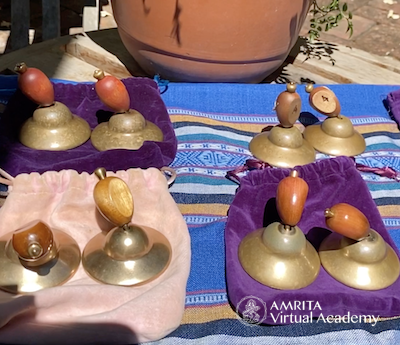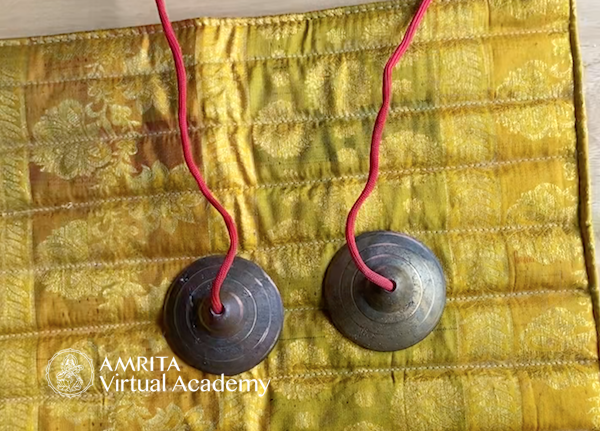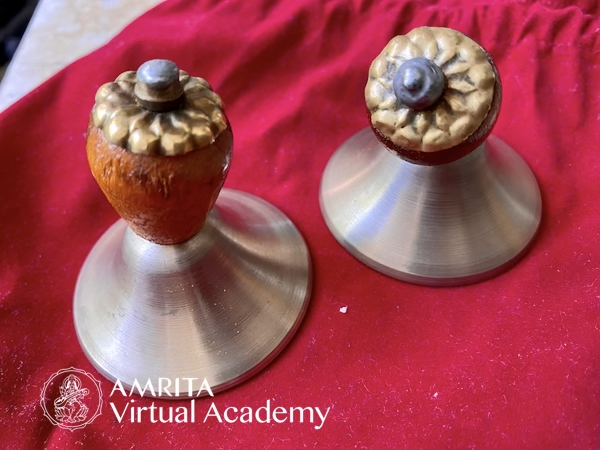
How to Select Kaimani (Hand Bells)
In order to really deepen one’s ability in playing an instrument, one must first truly understand it, appreciate it, learn about its historical significance, its physical properties, and how it’s used. Selecting any instrument is a highly personalized process and developing a special relationship of love and reverence towards it will help in honing in on the right instrument.
In the Kaimani: Level 1 Art of Handbells course, we spend some time learning about the ethnomusicology aspects of the Kaimani, its place in devotional music and its relevance in Amma’s bhajans. This kind of research and understanding will help you find the type of instrument you may be drawn to. Or maybe, I should say, that this kind of love and understanding will facilitate the process for the right instrument to find you!
What is a Kaimani?
Kaimani literally means hand (kai) bell (mani) in the Malayalam language. In North India, it is called Kartaal or Manjira or Manjeera. For South Indian Bharatanatyam (classical dance) it is known as Nattuvangam.
Used in temples and homes for centuries, this classical Indian instrument adds rhythm and beauty to devotional music. The bells create a soft and subtle tone, which are instrumental in keeping time. Notably, the Kaimani for Amma’s bhajans are tuned to specific keys (sruthis) and different sets of hand bells are often chosen based on the key of the bhajan.
Types of Kaimani

There are two types of Kaimani that are most used. The first, and more common one, is the stringed Kaimani. The cymbal is typically flat, polished, shiny and made out of brass or other bell metals. If the cymbal surface is smaller, lightweight, it will have a brighter tone with less resonance. The other type of stringed Kaimani has a bell shaped, textured cymbal. It has a deeper tone with a lower pitch than the flat kind. The bell itself is usually darker in color than the flat, polished variety.

The second type of Kaimani utilizes wooden or plastic beads as the main handgrip on each cymbal. These bells are usually a darker color, more resonant and have a deeper tone. If the bell has more of a cupped shaped and textured surface, it may have a lower and more resonant tone. Generally, the beaded Kaimanis are also louder and their sound can be overpowering. When you’re trying out different pairs of Kaimani, it’s important to consider the context you may be playing it. For example, if you are just practicing on your own in a small space, you might want a smaller and flat Kaimani that is lighter and less resonant. However, if you plan to play for live bhajans or kirtan sessions amidst loud amplified music, then a more resonant or deeper toned Kaimani would better suit that particular context. The beaded Kaimani are the more preferred type in Amma’s bhajan group. However, I have personally cherished playing the stringed kind for some of Amma’s bhajan sessions in order to get lighter texture that’s better for recordings.
In my early days of playing percussion instruments, I was quite enamored in selecting my instruments and forged a deep love and lasting connection with them. In fact, I used to hold the tabla and sleep with it closeby. These instruments are manifestations of the divine; the love or bond you develop with your instrument will truly help you progress in your playing.
If you are interested in getting a pair of Kaimani, please visit https://theammashop.org/
Learn more about the Kaimani by taking the Kaimani: Level 1- The Art of Handbells course
Wishing you all the best in your quest to find the perfect Kaimani & hope to see some of you in class!
Author: Anu Chechi, Kaimani Instructor, Amrita Virtual Academy
